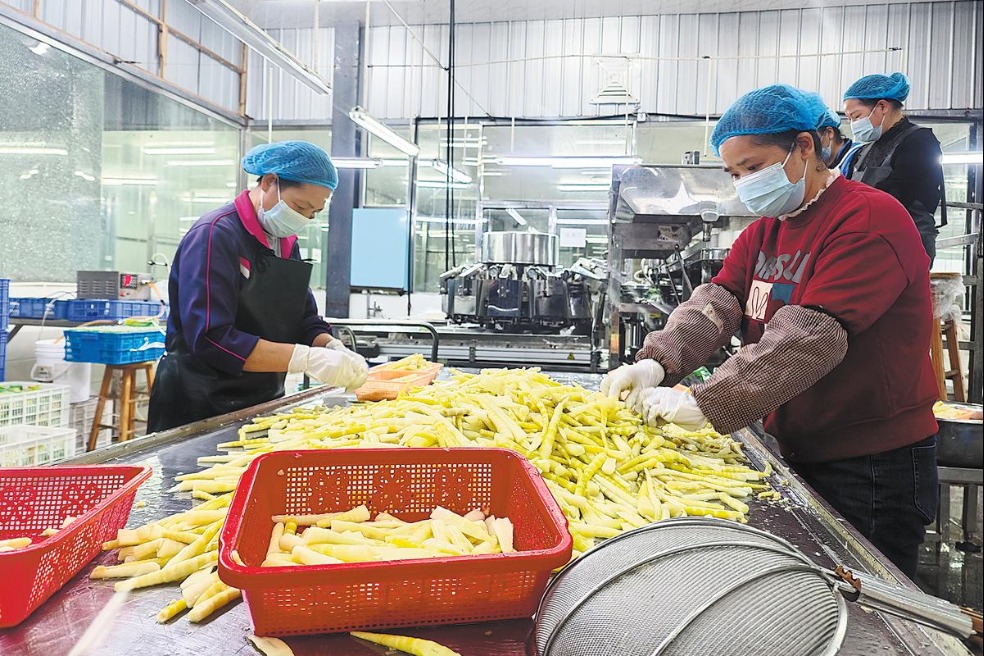Natural attraction
Tourists flock to a mountainous region of Sichuan to witness the riot of color caused by late autumn leaves, report Huang Zhiling and Pan Zhongming in Chengdu.

Despite the long journey and the ongoing pandemic, this time of year will still see photographers from different parts of Sichuan flock to Mount Guangwu in the province's remote Nanjiang county.
With its canopy of autumnal leaves covering a forest spanning 680 square kilometers, Guangwu boasts Asia's longest natural red carpet.
Most travelers find the trip to Guangwu from the Sichuan provincial capital of Chengdu laborious.
For those taking the train, they have to go to Chengdudong Railway Station to catch a bullet train bound for Hanzhong in Shaanxi province. After more than two hours of travel, upon arrival they are faced with a further hour in a taxi before they finally reach Guangwu.
But this "odyssey" is all worthwhile as the leaves are a breathtaking riot of color and beauty beyond description, says Meng Qi, a 67-year-old photographer.
The leaves started turning yellow and red on Guangwu in late October and the best season for viewing autumn leaves lasts around two months, says Gou Dan, head of the publicity department of the Nanjiang county committee of the Communist Party of China.
Trees in different parts of Guangwu enable travelers to see the autumn leaves until December because those on the lower parts of the mountain change color later.
Locals jokingly refer to it as the foggy mountain because mist occurs regularly, obfuscating the view, says Jiang Lei, deputy chief of the publicity department of the Nanjiang county committee of the CPC.
Guangwu also means only fog in Chinese.
When it is clear, however, Guangwu is spectacular in autumn as a wide expanse of forest is swathed in yellows and reds. When visitors look from afar, the forest seems to be on fire. When they sit in a moving car, travelers can mistake trees for people running with flaming torches.
In late October 2017, a poet viewed autumn leaves on Guangwu and had a poem Mount Guangwu Is on Fire published in the local newspaper, Bazhong Evening News, the following month.
Bazhong is the city which administers Nanjiang county.
The poem begins with the two lines: "Mount Guangwu is on fire. The mountain is burning everywhere."
Many people recited the poem, starting a rumor that a fire had actually taken place on Guangwu. Some people called the newspaper and even drove to the mountain in order to extinguish the fire, says Chen Lixian, vice-chairman of the Bazhong Writers' Association.
Even his mother in the countryside called him two days later and asked if the fire had been extinguished, says Chen, who, at that time, was on the editorial staff of the paper.
"I told my mother that the poem was not news. It was a poetic way of comparing the autumn leaves to a burning fire. She breathed a sigh of relief," he says.
To refute the rumor, the paper had to publish photos of the mountain and its autumnal coloring with the caption: "With red autumn leaves, Mount Guangwu receives more than 30,000 visitors in a single day."
The photos might have poured water on the rumor, but fanned the flames of interest among tourists. In the following days and weeks, they came from Chongqing municipality, Chengdu, Guizhou province and the Guangxi Zhuang autonomous region, jamming roads leading to the mountain, Chen says.
With 95 percent of its land being mountainous, Nanjiang was written about by Li Shangyin, a poet during the late Tang Dynasty (618-907).
In the middle of the ninth century, Li penned his famous poem To My Family in the North on a Rainy Night in Nanjiang on his way home to Shaanxi province.
After an overnight rain, the dirt-covered mountain roads in Nanjiang were inaccessible and Li was stranded for days. He lamented in the poem to his family: "You ask me when I can come back but I don't know. The pools in Nanjiang with autumn rain overflow."
The poem tells about the roads in Nanjiang becoming muddy and stranding travelers after a heavy rain more than 1,100 years ago, an issue that remained unchanged until China started implementing its reform and opening-up in the late 1970s.
While every village is now connected by road, Nanjiang, which belongs to the Qinling-Dabashan Mountain Area, a former key area for poverty alleviation as identified by the central government, was once one of the least accessible areas in Sichuan.
Just as the late Chairman Mao Zedong described in a poem, that only on the steep peaks can one get infinite beautiful scenery, Nanjiang possess superb mountain scenes, including those in the Mount Guangwu and Nuoshui River Geopark.
Covering 1,818 square kilometers, the geopark which covers Nanjiang and its neighboring Tongjiang county boasts karst formations, karst caves, 2,104 species of rare plants and 322 species of rare animals.
Beeches, known as a living fossil, have a distribution area of more than 70 square kilometers in the geopark which is China's largest preservation area of the tree species.





Today's Top News
- China to apply lower import tariff rates to unleash market potential
- China proves to be active and reliable mediator
- Three-party talks help to restore peace
- Huangyan coral reefs healthy, says report
- PLA conducts major drill near Taiwan
- Washington should realize its interference in Taiwan question is a recipe it won't want to eat: China Daily editorial






























